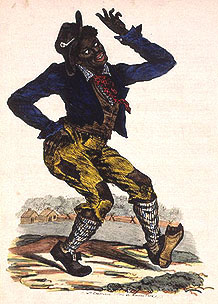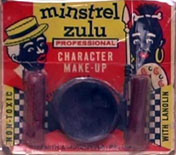Jim Crow Museum
1010 Campus Drive
Big Rapids, MI 49307
[email protected]
(231) 591-5873


The name Jim Crow is often used to describe the segregation laws, rules, and customs which arose after Reconstruction ended in 1877 and continued until the mid-1960s. How did the name become associated with these "Black Codes" which took away many of the rights which had been granted to black people through the 13th, 14th, and 15th Amendments?
"Come listen all you galls and boys,
I'm going to sing a little song,
My name is Jim Crow.
Weel about and turn about and do jis so,
Eb'ry time I weel about I jump Jim Crow."

These words are from the song, "Jim Crow," as it appeared in sheet music written by Thomas Dartmouth "Daddy" Rice. Rice, a struggling "actor" (he did short solo skits between play scenes) at the Park Theater in New York, happened upon a black person singing the above song -- some accounts say it was an old black enslaved man who walked with difficulty, others say it was a ragged black stable boy. Whether modeled on an old man or a young boy we will never know, but we know that in 1828 Rice appeared on stage as "Jim Crow" -- an exaggerated, highly stereotypical black character.
Rice, a white man, was one of the first performers to wear blackface makeup -- his skin was darkened with burnt cork. His Jim Crow song-and-dance routine was an astounding success that took him from Louisville to Cincinnati to Pittsburgh to Philadelphia and finally to New York in 1832. He also performed to great acclaim in London and Dublin. By then "Jim Crow" was a stock character in minstrel shows, along with counterparts Jim Dandy and Zip Coon. Rice's subsequent blackface characters were Sambos, Coons, and Dandies. White audiences were receptive to the portrayals of black people as singing, dancing, grinning fools.
By 1838, the term "Jim Crow" was being used as a collective racial epithet for black people, not as offensive as nigger, but similar to coon or darkie. The popularity of minstrel shows clearly aided the spread of Jim Crow as a racial slur. This use of the term only lasted half a century. By the end of the 19th century, the words Jim Crow were less likely to be used to derisively describe black people; instead, the phrase Jim Crow was being used to describe laws and customs which oppressed black people.

The minstrel show was one of the first native forms of American entertainment, and Rice was rightly regarded as the "Father of American minstrelsy." He had many imitators. In 1843, four white men from New York, billed as the Virginia Minstrels, darkened their faces and imitated the singing and dancing of black people. They used violins, castanets, banjos, bones, and tambourines. Their routine was successful and they were invited to tour the country. In 1845, the Christy Minstrels (for whom Stephen Foster wrote some of his most popular songs) originated many features of the minstrel show, including the seating of the blackface performers in a semicircle on stage, with the tambourine player (Mr. Tambo) at one end, and the bones player (Mr. Bones) at the other; the singing of songs, called Ethiopian melodies, with harmonized choruses; and the humorous banter of jokes between the endmen and the performer in the middle seat (Mr. Interlocutor). These performers were sometimes called Ethiopian Delineators and the shows were popularly referred to as Coon Shows.
Rice and his imitators, by their stereotypical depictions of black people, helped to popularize the belief that black people were lazy, stupid, inherently less human, and unworthy of integration. During the years that black people were being victimized by lynch mobs, they were also victimized by the racist caricatures propagated through novels, sheet music, theatrical plays, and minstrel shows. Ironically, years later when black people replaced white minstrels, the black people also "blackened" their faces, thereby pretending to be white people pretending to be black people. They, too, performed the Coon Shows which dehumanized black people and helped establish the desirability of racial segregation.

Daddy Rice, the original Jim Crow, became rich and famous because of his skills as a minstrel. However, he lived an extravagant lifestyle, and when he died in New York on September 19, 1860, he was in poverty.
The minstrel shows were popular between 1850 and 1870, but they lost much of their national popularity with the coming of motion pictures and radios. Unfortunately for black people, the minstrel shows continued in small towns, and caricatured portrayals of black people found greater expression in motion pictures and radios.
© Dr. David Pilgrim, Professor of Sociology
Ferris State University
Sept., 2000
Edited 2023
Additional images can be found here.
Bean, A., Hatch, J. V., & McNamara, B. (Eds.). (1996). Inside the minstrel mask: Readings in nineteenth-century blackface minstrelsy. Hanover, NH: Wesleyan University Press.
Cockrell, D. (1997). Demons of disorder: Early blackface minstrels and their world. Cambridge: Cambridge University Press.
Levy, L. S. (1976). Picture the songs: Lithographs from the sheet music of nineteenth-century America. Baltimore, MD: John Hopkins University Press.
Toll, R. C. (1974). Blacking up: The minstrel show in nineteenth century America. New York, NY: Oxford University Press.